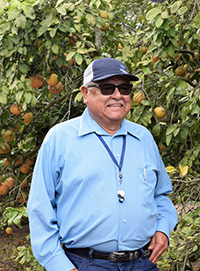 In South Texas, fruit size matters. Texas farmers produce citrus for the fresh market, and small fruit does not contribute to their marketable yield.
In South Texas, fruit size matters. Texas farmers produce citrus for the fresh market, and small fruit does not contribute to their marketable yield.
“When you have small fruit, that fruit is likely going to the processor to make juice. We're not in the juice business, we're in the fresh market business where size matters,” says Jose Silva, Texas fruit producer.
Without healthy soil, citrus trees cannot properly absorb the nutrients and water needed to produce marketable-sized fruit.
“The healthier the soil, the more abundant the fruit yield. That’s why it's important to focus on soil health and do what you can to improve your underground environment,” Silva says.
As manager for Edinburg Citrus Grove Care in Edinburg, Texas, Silva oversees 1,000 acres of mature, producing citrus groves and about 500 acres of nonbearing citrus.
“My responsibility as manager is to make sure that we produce the best quality, marketable fruit. We need healthy soil to do that,” he says. “The soil is home for the tree’s root system, and a healthy soil is vital for plant function. It’s critical that fruit producers pay attention to what's going on underneath the trees.”
Silva, who is also a certified crop adviser and holds a pest control adviser’s license, offers six tips to ensure healthy soils and high-yielding fruit trees.
- Increase microbial activity in soil by improving pH and salinity levels.
- Focus on water management.
- Promote proper drainage.
- Have a disease control plan.
- Beware of citrus nematode.
- Protect beneficial organisms.
Ideal pH levels increase nutrient availability to the plant.
The goal is to provide trees with the optimum amount of water for continued growth. Moisture probes buried within Silva’s groves help determine when and how much to irrigate.
If citrus groves do not properly drain after a heavy rain, standing water can injure tree roots and increase the likelihood of disease development.
“Phytophthora is one of our biggest disease issues in the Rio Grande Valley because about 80% of our citrus acres are flood irrigated,” Silva says. “We need to be ready to treat with a fungicide as soon as we see disease symptoms in the grove to minimize disease infestations.”
Nematode feeding damage shrinks fruit size, yield and overall grove production. Because plant-parasitic nematodes are not visible to the naked eye, Silva recommends both soil testing and scouting for above-ground symptoms.
“The citrus nematode can feast on a tree’s feeder roots to the point where you'll start seeing some leaf curl within the tree canopy,” he says. “Heavy nematode pressure will also result in small leaves and smaller fruit.”
Nematode populations above threshold levels can kill trees.
“Here in South Texas where temperatures are often above 100 degrees, it doesn't take much to have a tree wilt due to nematode feeding, because damaged roots are not efficiently taking water up to the tree,” Silva says.
Silva recommends testing for nematodes just before fall and spring root growth. If a treatment is needed, a nematicide can be applied during root flush.
“If I were to take a shovel and dig down to the feeder roots during root flush, you'll see young white tips on those roots. Those are feeder roots. If the root is brownish, they're not flushing out yet,” he says. “When you see the tree pushing new leaves, the feeder roots are flushing.”
“We produce better quality fruit when we control plant-parasitic nematodes such as the citrus nematode,” he says. “However, not all nematodes or soil organisms are bad. When we make a recommendation to treat a pest, we try not to disturb the surrounding beneficial organisms that improve soil health.”